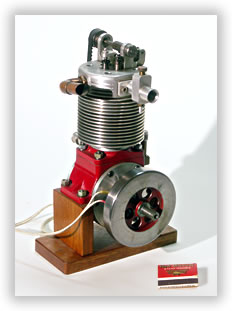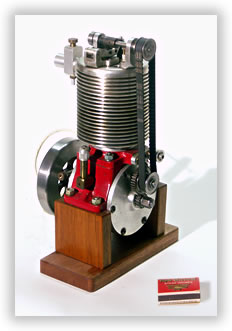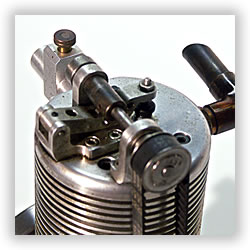
Above: right side view
Below: left side view

|
|
ENGINE NO. THREE DATA
Cylinders: 1
Type: Vertical single with atmospheric
intake
Bore: 1.625”
Stroke: 1.875”
Displacement: 3.94
cu in
Compression Ratio: 6:1
Ignition: Spark plug
Cooling: Air
Fuel: Gas or 15% nitromethane/methanol mix
Max. RPM: 6,000
Est: Horsepower: 3
BUILDER'S NOTES
Background -- Not long before
this engine came into being I had built a very light, Whitehall
design, rowing boat. Rowing is very good exercise but the
range can be limited. I had the thought that an engine could
be designed which could be governed and light enough to mount
on this boat. This would extend the range (yes, I've heard
of outboard motors, but that would have taken all the fun out
of it).
This air-cooled
unit uses an atmospheric (automatic) intake valve. Many older
engines used this system; there’s no cam on the
spring-loaded intake valve that opens from cylinder vacuum
when piston is on down stroke. Thus, there’s no control
over valve timing.
Construction -- This engine
used castings I produced in my own little foundry (click here
for more on castings).
The rocker cam, a timing belt driven cam, was used for the
exhaust valve. A flyball governer was used to block the intake
cam and thus control the engine speed. The displacement was
3.9 cu.in. which is larger than I usually build.
Operation -- The
final results were mixed. It ran okay and governed at about
3000 r.p.m. The main problem was that the governing was quite
abrupt because of the fairly light flywheel. I found that I'd
need a much larger flywheel to tame this engine, which would
defeat the purpose of a light, low-speed boat motor. Well,
you don’t
win them all. It was not prudent to carry the development
any further. The automatic speed control did actually work
okay, as the max speed without the governer was about 4500
r.p.m.
On Spark Plugs and Glow
Plugs...
It was difficult to find
small commercial spark plugs so I built quite a number of my
own using Corian as the material for the insulator. For most
of my later engines I changed to glow plugs. Although spark
plugs give a bit better flexibility, the final performance
of glow plugs is almost as good and a lot simpler. Almost
all model engines now use glow plug ingnition.
In multiple cylinder engines however, it takes a lot of amperage
to light the glow plugs since they are in series. Also, if
one plug goes out it usually takes out the rest out due
to the increased current draw.
|
|

Detail of valve actuation
mechanism.
ENGINE DETAIL PAGE LINKS
(click on buttons)
|

